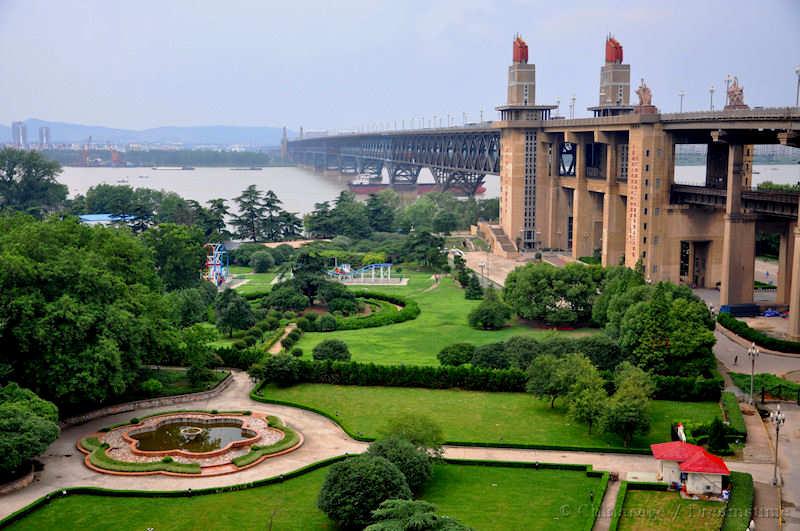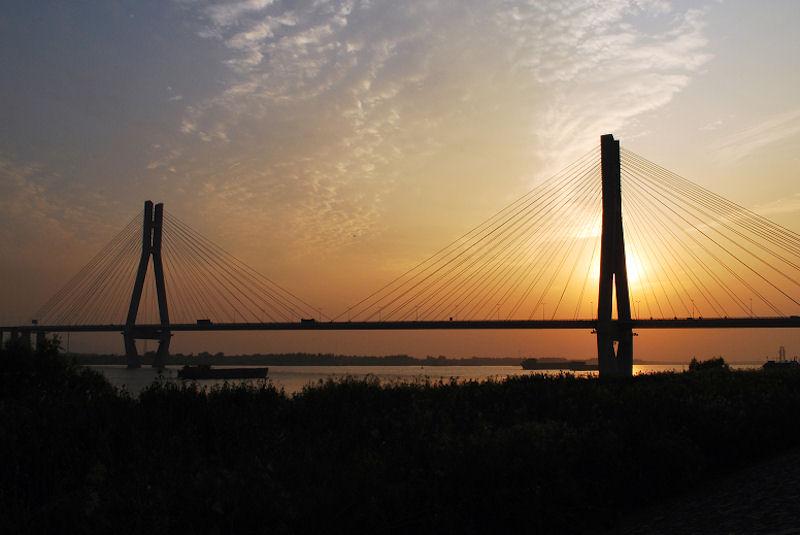Yangzi River 长江
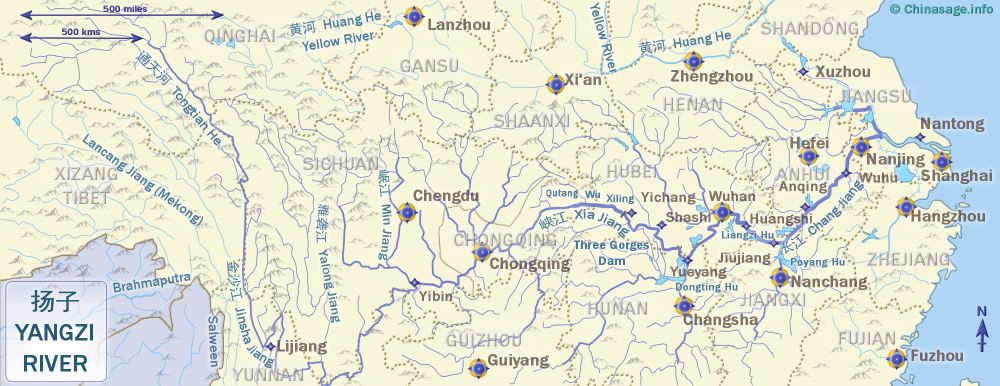
The Yangzi river (长江), still often known by its old name of Yangtse WG, is the third longest river in the World and drains a vast basin of 772,200 sq miles [1,999,989 sq kms] with a flow of 29,000 m3 at its mouth, making it the second largest after the Amazon ➚ and has over 20 times the flow rate of the Yellow River. The build up of silt at its estuary advances its delta (and the country of China) by about 60 feet [18 meters] each year.
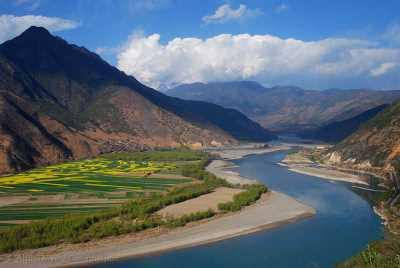
Route of the Yangzi
The Yangtse river rises in Qinghai province, flows south to form the border between Tibet and Sichuan and then enters Yunnan where it makes an about turn to head north east back into Sichuan. Legend has it that Yu the Great placed the Yun (’cloud’) range of mountains in its path to divert it east into China. Here is the famous Tiger Leaping Gorge in Yunnan where it flows in a very narrow but deep canyon. It then continues through the three famous gorges (Xiling, Wu and Qutang) in the province of Chongqing. After the Three Gorges dam the Yangzi enters the lowland lakes of Hubei. The river then meanders slowly through Anhui before reaching the sea in Jiangsu. Shanghai lies close to its mouth where it enters the East China Sea. Three great cities and provincial capitals are located along its way: Chongqing, Wuhan and Nanjing. Nanjing has at times been the capital of the whole of China.
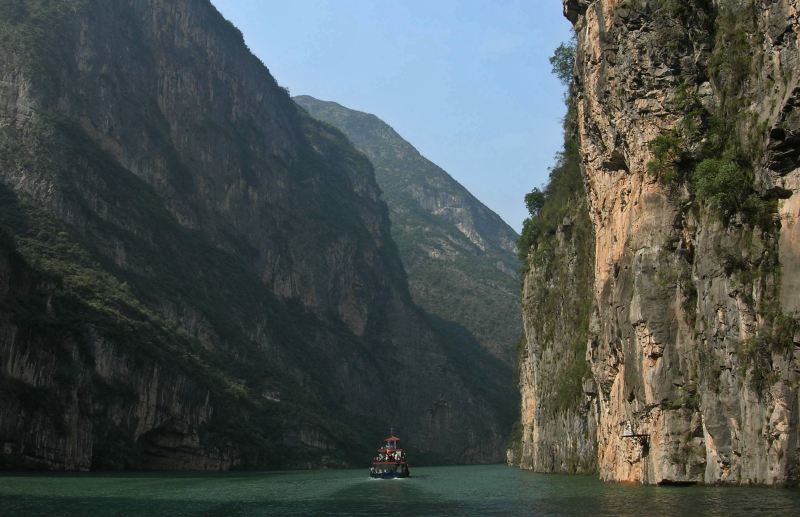
Huge lakes, most notably Poyang and Dongting located in the lower reaches act as buffer stores for summer rains to help prevent flooding further downstream. The river has always been a major conduit of goods and people as the Yangzi is easily navigable upstream as far as Wuhan and Yichang.
Three Gorges Dam
The Three Gorges giant dam ➚ (Sanxia) built just upstream of 三斗坪镇 Sān dǒu píng zhèn was completed in 2006 had three main benefits: generation of 67 billion KW/h of hydro-electric power; flood prevention and better navigation up to Chongqing. The dam is 600 feet [183 meters] high and 1,243 miles [2,000 kms] wide and creates a 400 miles [644 kms] long reservoir. It is the largest hydro-electric power station in the world, but not the largest dam. To navigate up and downstream ships take nearly three hours to pass through the largest lock system in the world at the dam. A smaller dam at 葛洲坝 Gé zhōu bà was completed in 1988. The original plans were drawn up with American help in the Chiang Kaishek era, the project was then taken up by Mao Zedong and carried out after his death. With the higher river level more boats can now reach Chongqing far more quickly, but at the cost of the displacement of 400,000 people. Most Yangzi river cruises ply their trade between Chongqing and the Three Gorges dam. For a full description of the dam this CNN page ➚ offers a good overview.
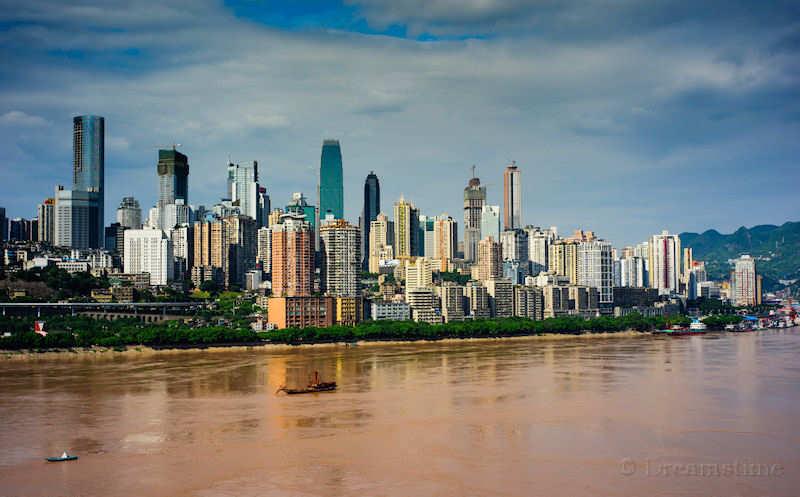
Yangzi History
During the Song dynasty the Mongols invaded from the north and so the capital of China moved to Hangzhou and the Yangzi river became the focus of the Chinese nation rather than the Huang He (Yellow River) further north. It has divided northern and southern China over the centuries forming a barrier to conquest. After the Taiping Rebellion, Britain and other foreign powers sought to increase their influence on the Yangzi basin, and had trading concessions at Hankou (which is now part of Wuhan) and Chongqing. Originally teams of trackers hauled boats upstream through the dangerous rapids of the gorges aided by pilots. Foreign steamboats and gunboats frequently sailed up the Yangzi as far as Chongqing, although they still needed the help of trackers and pilots over the difficult stretches of rapids. During the days of the Japanese occupation (1931-1945) Chiang Kaishek ruled ‘Free China’ from Chongqing and he controlled the upper Yangzi valley. During this period, in July 1935 the Yangzi suffered its worst flood in modern times, killing about 140,000 people and flooded an area about the same of the whole UK. Previous and equally damaging floods occurred in 1911 and 1530, the Three Gorges Dam should prevent such disastrous flooding ever happening again.
The Yangzi was the scene of an International incident at the end of the Civil War. In April 1949, the Nationalists were being pushed south by the Communist Army. A British ship, the HMS Amethyst ➚, came under attack by the Communists and had to steal away at night down the Yangzi. It is thought the attack may have been because the Amethyst was mistaken for a Nationalist gunboat. The event marked the end of foreign gunboat incursions up the river, from then on foreign ships only sailed with government permission.

The Yangzi River has for long been the natural division between northern and southern China. It was as late as 1957 ➚ that the first bridge was built over it on the lower reaches at Wuhan . East of 宜昌 Yí chāng there were no bridges and so railway carriages had to be unhitched and taken by ferry across the river. Later an even mightier bridge downstream at Nanjing was completed in 1968. In the last 20 years many new bridges have been constructed and there are now more than 100 bridges ➚ over the lower stretches. The Yangzi has a navigable network of 43,496 miles [70,000 kms] with 3,000 ton ships able to make the 1,000 miles [1,609 kms] journey from its mouth to Chongqing. Near its mouth the river was home to the freshwater dolphin: the Baiji ➚ but due to pollution and over-fishing it has become extinct.
Yangzi by any other name
As with many names for Chinese places 扬子 Yangzi is not used in China for the river, except may be, for a short section between Zhenjiang and Jiangdu in Jiangsu. Yangzi means son of the ocean, although this may be an early transcription error, reading 洋 yáng ocean instead of 扬 yáng a place name. In China just 江Jiāng (meaning “The River”) is perfectly good enough. 长江 Cháng jiāng Long River or 大江 Dà jiāng Great River are also used.
The upper stretch in Qinghai is called 通天河 Tōng tiān héRiver to heaven then becoming 金沙江 Jīn shā jiāng金沙江 Golden sands river above Dukou in Sichuan, possibly due to the presence of some alluvial gold. Here it is joined by the mighty 雅砻江 Yǎ lóng jiāng. At Yibin it meets the 岷江 Mín jiāng to become the 大江 Dà jiāng Great River. The stretch through the gorges is sometimes called the 峡江 Xiá jiāng Gorge River. However for much of its lower reaches it is called 长江 Cháng jiāng Long River.
